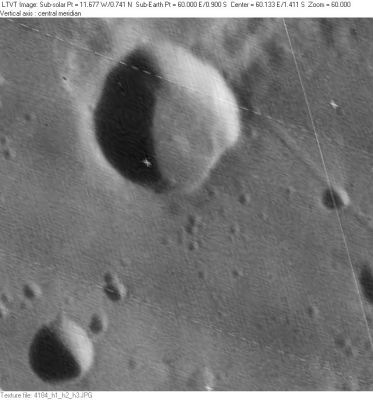Webb
Contents
Webb
|
Lat: 0.9°S, Long: 60.0°E, Diam: 21 km, Depth: 1.85 km, Rükl: 49 |
LO-IV-184H The 10-km crater in the lower left corner is Webb H. The rille on the right is unnamed.
Images
LPOD Photo Gallery Lunar Orbiter Images Apollo Images
WARNING: because of some mysterious reason only known at the LPI, Apollo 16's stereoscopic ITEK-camera photographs of Webb and its surroundings (made during A16's REVOLUTION 47) are all in the REV 47 Forward Facing Camera magazine. The REV 47 Aft Facing Camera magazine shows no photographs of Webb.
- Lunar Orbiter 1's Frame 029 shows Webb (near lower left corner), Condon (left of photograph's centre), Townley (near upper right corner), and bright Petit (south of Townley).
- An oblique northward look at Webb is seen in Apollo 16's orbital ITEK-panoramic frames AS16-P-4426 and AS16-P-4431. Webb was captured near the right margins of both frames.
Additional research Lunar Orbiter 1 and Apollo 16 photographs: Danny Caes
- Apollo 11's Hasselblad AS11-42-6300 shows Webb U, and not Messier D as mentioned in the caption. Discovery of error: Danny Caes. Discovery of depicted region's exact location: Nunki (visitor of LPOD site) and Jim Mosher.
Maps
(LAC zone 80A2) LAC map Geologic map LTO map
Description
Description: Elger
(IAU Directions) WEBB.--A ring-plain W. of Maclaurin, about 14 miles in diameter, with a dusky floor, enclosed by a bright rim, on the N.W. side of which there is a small crater. Schmidt seems to have overlooked the central hill.
Description: Wikipedia
Additional Information
- Depth data from Kurt Fisher database
Pike, 1976: 1.85 km
Westfall, 2000: 1.85 km - Webb H is a thermal anomaly crater, implying a youthful age - Moore et al, 1980
- A small rille near Webb was imaged by KC Pau and reported in the Fall 2006 issue of Selenology: Journal of the American Lunar Society.- fatastronomer
Nomenclature
- Named for Thomas William Webb (December 14, 1807 - May 19, 1885), a British astronomer. In addition to serving as a clergyman, T.W. Webb pursued astronomical observation in his spare time. In 1859 he wrote his classic astronomical observing guide Celestial Objects for Common Telescopes for which he is best known today. This two volume work was written as a guide the amateur astronomer, containing instructions on the use of a telescope as well as detailed descriptions of what could be observed with it. This work became the standard observing guide of amateur astronomers worldwide, and remained so until well into the 20th Century, gradually supplanted by more modern guides such as Robert Burnham's Celestial Handbook.
- This name was part of the original IAU nomenclature. According to Whitaker (p. 223), it was introduced by Neison.
- Perhaps interesting to know that there was also a James Edwin Webb; the second administrator of NASA; 1961-1968.
LPOD Articles
Bibliography
Harold Hill. A Portfolio of Lunar Drawings, page 215.
T. W. Webb in the Sourcebook Project (William R. Corliss)
In Mysterious Universe, a handbook of astronomical anomalies (1979) :
- Page 56: Supposed Discovery of Vulcan (Lewis Swift, Observatory, 1878).
- Page 100: Visibility of the Dark Side of Venus (Robert Killip Sale, Journal of the British Astronomical Association, 1895).
- Page 126: The Maedler Phenomenon (Richard Baum, Strolling Astronomer, 1978).
- Page 136: The Satellite of Venus (Nature, 1876).
- Page 142: The Problematical Satellite of Venus (Observatory, 1884).
- Page 197: On the Obscuration of the Lunar Crater Linne (W.R.Birt, American Journal of Science, 1867).
- Page 216: Curious Lunar Formation (Gruithuisen's so-called Lunar City) (C.Gaudibert, English Mechanic, 1874).
- Page 459: An Occultation Phenomenon (Edwin Holmes, Journal of the British Astronomical Association, 1903).
- Page 479: On the Reversed Curvature of the Shadow on Saturn's Rings (Aldro Jenks, Sidereal Messenger, 1890).
